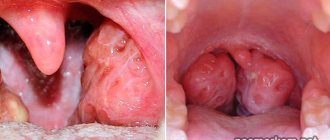The tonsils or palatine tonsils are an important protective organ located in the human throat. It serves as a barrier to pathogenic bacteria, dust particles and food, and also produces antibodies. In chronic diseases of the nasopharynx, the tonsils do not have time to clear themselves, which leads to the accumulation of pus and mucus on their surface.
Outwardly, this pathology resembles white lumps in the throat with an unpleasant odor. The affected area becomes inflamed, which leads to increased activity of pathogens. Tonsil masses may go away on their own, but it is recommended to consult a doctor to prevent possible complications.
Symptoms:
- red, swollen tonsils with white or yellowish coating or streaks;
- a sore throat;
- difficult and/or painful to swallow;
- fever (temperature above 38.0);
- cervical lymph nodes are enlarged;
- hoarse or hoarse voice;
- headache;
- stiff neck muscles;
- abdominal pain (especially in young children).
In infants:
- drooling due to pain in swallowing;
- anxiety;
- refusal to eat
- With chronic tonsillitis, your breath may smell bad.
Causes of tonsil cancer
Not so long ago, it was assumed that the leading role in the etiology belongs to the use of strong alcoholic beverages in combination with aggressive smoking or the tradition of chewing psychoactive plants and herbal mixtures - nasa and betel by some eastern peoples.
In recent years, it has become established that the malignant process is caused by the activity of human papillomavirus types 16 and 18, similar to cervical carcinoma.
Risk factors include occupational hazards - tension in the vocal apparatus and chronic inflammatory processes - tonsillitis, tonsillitis.
Complications of tonsillitis
- Labored breathing.
- Sleep apnea (holding your breath during sleep).
- Spread of infection to the tissue near the tonsils (peritonsillitis), peritonsillar abscess - accumulation of pus behind the tonsil.
- Acute cervical lymphadenitis is inflammation of the cervical lymph nodes.
Streptococcal tonsillitis can cause complications such as:
- acute rheumatic fever, affecting the joints, heart and other organs;
- glomerulonephritis (inflammation of the kidneys, which can lead to serious consequences, including kidney failure).
Treatment with antibiotics significantly reduces the likelihood of complications after streptococcal sore throat.
Possible complications
It is believed that if the white balls are caused by chronic tonsillitis, then you need to worry less. In this case, they will go away on their own with proper treatment. The greatest danger is intoxication of the body, as well as the risk of developing intestinal dysbiosis, since bacteria developing on the tonsils enter the digestive tract. In addition, there is a possibility of the formation of secondary stomatitis and caries on the tooth enamel.
A long-term illness leads to severe discomfort for a person, since an unpleasant odor is difficult to hide during a conversation. In the future, it may be intensified by diseases of the oral cavity.
Diagnosis of tonsillitis
- For tonsillitis, the doctor will examine the child's throat, as well as his ears and nose, where there may also be inflammation.
- The doctor will examine the child's skin, since streptococcal sore throat sometimes causes a specific rash. This is what is called “scarlet fever” - it is not some kind of separate disease, but a sign of damage to the body by streptococcus.
- The doctor will feel the cervical lymph nodes - as a rule, with tonsillitis they swell.
- The doctor will feel the spleen to distinguish a sore throat from mononucleosis, which also causes swollen lymph nodes.
- The streptococcal test is a simple and accurate way to distinguish streptococcal tonsillitis from viral tonsillitis. The doctor takes a scraping from the child’s throat and within 24-48 hours the result is ready.
- In some cases, a general blood test may be needed, the results of which can also indicate the viral or bacterial nature of the disease. It is usually taken if the streptococcal test is negative, but the course of the disease leaves the doctor in doubt.
About the clinic
Euromed Clinic is a multidisciplinary family clinic in the center of St. Petersburg.
- Calling a doctor to your home
- 24/7 therapist appointment
- Tests, ultrasound, x-ray
- Whole body diagnostics
- Hospital and surgery
- Vaccination
Find out more about the clinic
Treatment of tonsil cancer
For any prevalence, excluding metastatic stage 4, surgical treatment is recommended at the first stage - removal of the tumor and lymph nodes affected by metastases.
If surgery is not possible, radiation is carried out in combination with chemotherapy or chemotherapy is performed sequentially, and then radiation therapy, and again the issue of surgical treatment is resolved. But if the cancer is completely regressed as a result of conservative measures, you can stop there; if there is any remaining cancer in the irradiation zone, removal is suggested.
The metastatic process is subject to systemic treatment - cytostatics in combination with immuno-oncological drugs. The spectrum of cytostatics is quite wide; 4 monoclonal antibodies have demonstrated effectiveness.
Treatment of tonsillitis
The child should be provided with:
- peace and the opportunity to sleep as much as he wants;
- Drink plenty of fluids to relieve sore throats and prevent dehydration;
- air humidification;
- a sore throat can be relieved by both warm drinks and cold ice cream, especially popsicles;
- for a sore throat, it helps to gargle with a solution of table salt and soda - a teaspoon of salt and a small pinch of soda per 250 ml of warm water;
- Children over 4 years old can be offered lozenges for sore throats. Do not give candy to small children - they may choke;
- do not smoke when your child is sick, avoid strong odors that irritate the throat;
- A sore throat and fever can be relieved by medications containing paracetamol and ibuprofen. Don't give children aspirin; in rare cases, it can cause deadly Reye's syndrome.
Confirmed bacterial tonsillitis (usually streptococcal tonsillitis) is treated with antibiotics. It is dangerous to interrupt or stop the course because it increases the likelihood of infection spreading to the joints, heart, kidneys and other organs. Continue taking antibiotics even if your symptoms are completely gone.
Symptoms of tonsil cancer
Detecting the disease is very simple - just look in your mouth. It is a paradox that in stages 1-2 the process is detected only in 17%, and stage 4 with metastases is diagnosed in 45% of cases. Absolutely visual - accessible to daily and, if you want, hourly inspection, the anatomical region skillfully hides its diseases with a long period of absence of any symptoms.
A cancerous tumor does not hurt, a person does not notice bleeding from an ulcer, because he swallows the blood with saliva, there is enough space for food to pass through. An enlarged tonsil can block half of the pharyngeal lumen, only then does the owner notice it, because it interferes with the passage of solid pieces of food.
The leading clinical sign is a dense tumor, very often with a non-healing ulcer with rough edges, the bottom is covered with a white-yellow coating, and everything is painless. A tonsil tumor can spread deep into the facial skull and even its base, involving the carotid artery.
Often the first sign is an enlarged lymph node in the neck due to metastases or difficulty swallowing. Lymph nodes enlarged by metastases are quite noticeable, very dense, over time, they are firmly fixed to the muscle tissue and grow into the skin; pain appears when the nerve bundle is compressed. In the central part of the lymph node, the nutrition of the tumor tissues is disrupted, they begin to disintegrate, leading to bleeding.
Tumor lesions of the oral cavity are easily joined by bacterial and fungal flora, causing inflammation with a putrid odor, bleeding foci of decaying tissue appear, leading to intoxication and a systemic inflammatory reaction. The patient’s nutrition is disrupted, exhaustion and the painful syndrome of cachexia-anorexia increase.
| More information about treatment at Euroonco: | |
| ENT oncologists | from 5100 rub. |
| Chemotherapy appointment | 6900 rub. |
| Emergency oncology care | from 12100 rub. |
| Palliative care in Moscow | from 44,300 rubles per day |
| Radiologist consultation | 11500 rub. |
Early stages of infection
Juvenile formations on the tonsils have different causes, but if there is a conclusion that the child has been diagnosed with the papilloma virus, this requires parents to constantly monitor and pay attention to their health status. Specialists from the first children's medical center in Saratov will help you decide on the most effective preventive and therapeutic measures. If your child often coughs for no apparent reason, or says that he has an uncomfortable sensation of the presence of a foreign object in his throat, immediately sign up for a consultation and visit a specialist who will select the most appropriate and effective treatment.
How is tonsil mass treated?
Traditionally, in the fight against otitis media or exacerbation of chronic tonsillitis, antibiotics and concomitant therapy are prescribed to minimize the negative impact on the gastrointestinal tract. If formations on the tonsils are confirmed and their nature is clarified, treatment is prescribed by a specialist. It is forbidden to rip off or burn papillomas yourself.
An experienced otolaryngologist, as well as with the necessary consultation of a professional surgeon, prescribe the most effective treatment methods, including:
- removal of tumors with laser;
- radio wave excision;
- freezing and removing formations using cold;
- electrocoagulation, when the papilloma is removed using current.
The method is selected taking into account:
- degree of damage;
- age;
- general condition of the body;
- individual reactions.
The papilloma virus cannot be cured, but everything can be done to block its manifestation.
Make an appointment with a surgeon
Choose a doctor
What to do if growths are visible in a child’s throat?
It is not uncommon for tumors to appear on the tonsils. This is a consequence of the papilloma virus, which manifests itself on the skin and mucous membranes. It would seem, where can a child catch this dangerous virus, which infects more than 70% of all inhabitants of the planet? First of all, in the womb, during birth, and also through contact and everyday life.
In the pharynx, neoplasms are most often found on the tonsils, but can be on the small tongue, palatine arches, and buccal mucosa. Only a pediatrician or otolaryngologist can make a diagnosis after examination.
Neoplasms on the larynx in children can form from birth; clinical manifestations often manifest in early childhood from 2 to 5 years. In children, this form of the disease indicates that treatment is necessary quickly and as competently as possible. Only an ENT doctor can diagnose such a localization of the process.
The active papilloma virus most often affects boys, but after 30 years, more women are affected. As a rule, the growths begin to manifest as impaired vocal function in the form of hoarseness, decreased timbre and rapid fatigue.
How dangerous is this?
Often papillomas on the tonsils are benign in nature, but at any age it is not worth the risk, and it is better to initially seek professional advice to eliminate all risks. Medical specialists identify the following among the main factors provoking the appearance of education:
- heredity;
- violation of metabolic processes;
- frequent colds and their complex course.
What color are the formations?
Papillomas blend in with the color of the mucous membrane of the throat, but sometimes they can change their pigmentation, becoming light pink or dark brown. Initially, one formation may appear, which is similar in size to a pea or the head of a pin. Over time, the number of formations can increase significantly and the lesion will look like a cauliflower with multiple papillomas. Sometimes the appearance process can be accompanied by inflammation.
How to protect the body?
Since more than 600 strains of human papillomavirus are known in the world today, it is difficult to combat such microparticles comprehensively and constantly. First of all, it is necessary not only to see a doctor once, but also to undergo a regular course of treatment. Using folk remedies without supervision from medical personnel, formations on the larynx can develop into a malignant tumor, so self-medication, especially if the patient is a child, is strictly prohibited.
During the transitional climatic period, as well as in winter, there is a frequent exacerbation of chronic tonsillitis. This is due to the fact that the child does not always inhale frosty cold air through the nose, but breathes through the mouth. As a result, it is observed:
- elevated temperature;
- inflammatory processes in the throat;
- dry or wet cough;
- weak appetite;
- bad mood, high level of moodiness.
At an appointment with an otolaryngologist, a red throat is also diagnosed, and as a result, complications can spread to the nose, causing a chronic runny nose, and to the ears, causing otitis media, which is difficult and painful.
Sometimes, due to the fact that there is an exacerbation of chronic tonsillitis, it is difficult to visually determine the presence of a growth on your own. A swollen throat does not allow you to independently diagnose the formation, and if you do not consult a doctor for primary indications, you can lose valuable time for treatment.
There are times when, when it is necessary to treat otitis, all attention is switched to inflammatory processes in the ear, and parents do not even look into the child’s oral cavity. As a rule, concomitant diseases of the ear-nose-throat-system occur together, and competent comprehensive treatment is important so that getting rid of one ailment does not switch the development of the disease and complications in the other direction.
In the most advanced cases, complete removal of the affected “tonsil” is required (as patients often call the palatine tonsils). That is why it is important to consult a doctor in time to minimize this risk. If a child has frequent manifestations of colds, laryngitis or pharyngitis is diagnosed, then in addition to consultations with specialists at the center during the active stage and recovery from the disease, it is worth regularly showing the baby to doctors in order to exclude possible complications in the development of diseases.
The tumor on the tonsil itself does not go away, it may simply decrease in size, but this is not a reason to put off visiting a specialist. You shouldn’t risk your health, much less the health of your baby. Particular attention to the throat cavity should be paid in the following cases:
- when visiting a kindergarten and mass illness of children in it;
- when starting visits to sports sections, in particular the swimming pool.
A gathering of people who may also be carriers of the papilloma virus in one place can negatively affect the child’s health. The reason for a more thorough analysis of the throat cavity may be the use of antibiotics before this, non-compliance with the hygiene regime, as well as the active manifestation of oral diseases. If before this the child had a sore throat, and is now in the recovery period, then it is worth paying special attention to the condition of the throat in order to protect the child from formations on the tonsils. In case of mild laryngitis or pharyngitis, experts recommend carefully observing the child’s throat for a couple of days. To do this, in the morning and evening, ask the child to open his mouth to visually inspect for any formations on it, watch how the child eats, drinks and breathes.










